 |
|
Yokota Air Base
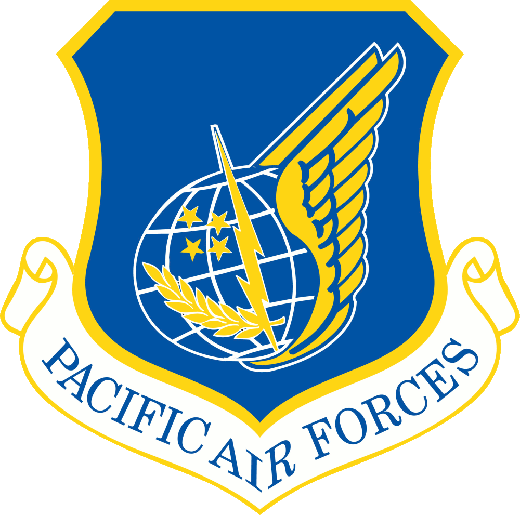
Part of United States Pacific Air Forces (PACAF)
横田飛行場
Yokota Kūgun Kichi |
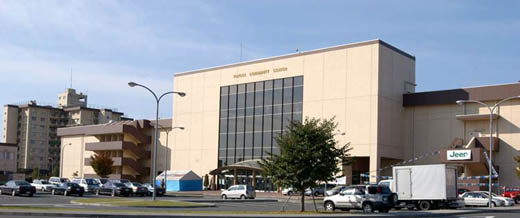 |
IATA: OKO – ICAO: RJTY
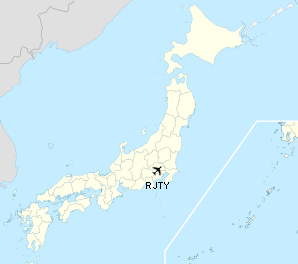
|
| Summary |
| Airport type |
Military |
| Operator |
United States Air Force |
| Location |
Fussa, Tokyo |
| Elevation AMSL |
463 ft / 141 m |
| Coordinates |
35°44′55″N 139°20′55″E / 35.74861°N 139.34861°E / 35.74861; 139.34861 (Yokota Air Base)Coordinates: 35°44′55″N 139°20′55″E / 35.74861°N 139.34861°E / 35.74861; 139.34861 (Yokota Air Base) |
| Website |
www.yokota.af.mil |
| Runways |
| Direction |
Length |
Surface |
| m |
ft |
| 18/36 |
3,353 |
11,001 |
Concrete |
| Source: Japanese AIP at AIS Japan |
Yokota Air Base (横田空軍基地, Yokota Kūgun Kichi), (IATA: OKO, ICAO: RJTY) is a United States Air Force base located in the city of Fussa, one of the 26 cities located in the Tama Area, or Western Tokyo.
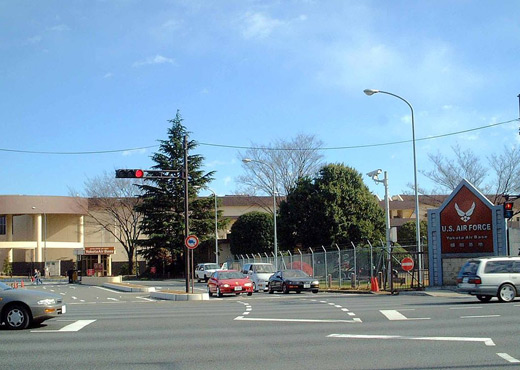
Yokota Air Base
Click to enlarge
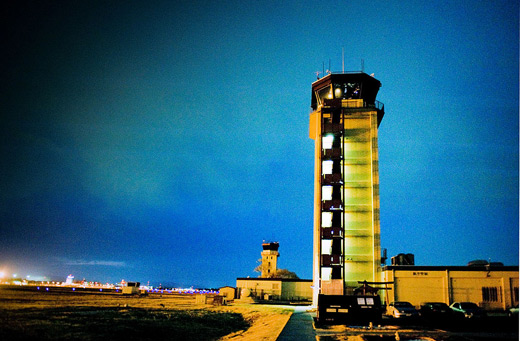
Yokota Air Base - The air traffic control tower at Yokota Air Base
Click to enlarge
The base houses 14,000 personnel. The base occupies a total area of 136,413 m (1,468,340 sq ft) and has a 3,353 × 61 m (11,001 × 200 ft) runway. Among its facilities are the broadcast center for the American Forces Network Tokyo radio service and a detachment of PACAF's Band of the Pacific. Units
The host unit at Yokota is the 374th Airlift Wing and is currently used for airlift missions throughout East Asia. The 374th includes four groups: operations, mission support, maintenance and medical. Each group manages a various number of squadrons in order to carry out the wing's mission.
- 374th Operations Group (Tail Code: YJ)
The 374th Operations Group maintains a forward presence by providing rapid responsive movement of personnel, equipment and operational support in the Asia-Pacific region. The group consists of:
- 374th Operations Support Squadron
- 36th Airlift Squadron (Lockheed C-130H1 Hercules)
- 459th Airlift Squadron (Bell UH-1N Iroquois (Huey)), (C-12J Huron)
It is not uncommon to see a C-5, KC-10, DC-8, C-17, L-100, civilian charter airline aircraft (Omni International, North American Airlines, World Airways, Ryan International, etc.) and cargo 747s on the Transient Aircraft ramp.
- 374th Maintenance Group
The 374th Maintenance Group maintains C-130H2, C-12 and UH-1N aircraft supporting intratheater airlift and distinguished visitor transport for Pacific Air Forces.
- 374th Mission Support Group
The 374th Mission Support Group is responsible to the 374th Airlift Wing Commander for command, control and direction of support activities to 374 AW and 32 tenant units to include HQ US Forces Japan and Fifth Air Force.
- 374th Medical Group
The 374th Medical Group, ensures medical readiness of 374 AW, 5 AF, and US Forces Japan personnel. They also maintain 64 War Reserve Materiel projects, including the USAF's largest Patient Movement Item inventory.
- Associate/Tenant Units
- U.S. Forces, Japan (USFJ)
- Fifth Air Force (5AF)
- 730th Air Mobility Squadron
- Air Force Band of the Pacific-Asia
- Stars & Stripes
- American Forces Network
- U.S. Coast Guard (USCG) Activities Far East (FEACT) (inspection of ships bound for U.S. ports for port control and safety reasons).
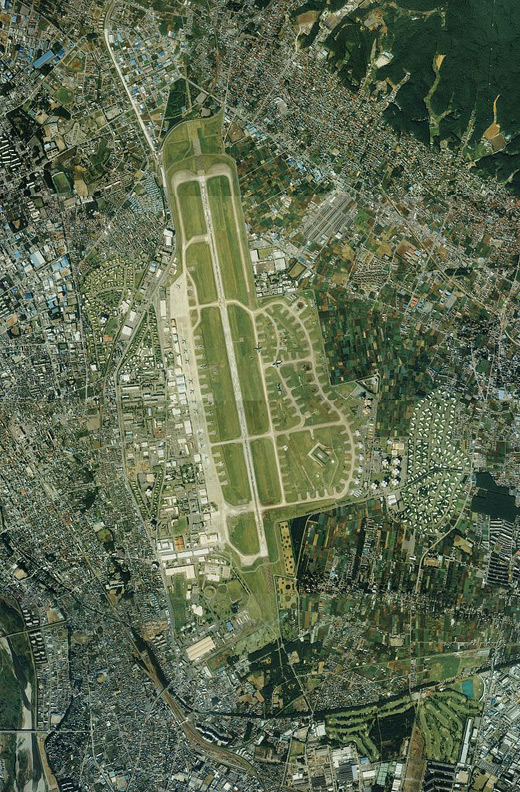
Yokota Air Base - The air traffic control tower at Yokota Air Base
Click to enlarge
AMC passenger terminal
The newly-renovated Air Mobility Command (AMC) Passenger Terminal is located on the main part of the base next to the flightline. It is a 5- to 7-minute walk from the Kanto Lodge (see below) and offers Space-Available flights to various destinations in PACAF such as Singapore, Korea, Hawaii, Guam, as well as the Continental United States.
History
Major commands
- 1st Cavalry Division, United States Army Forces Pacific, (September 1945)
- Pacific Air Command US Army, (September 1945 - January 1947)
- Far East Air Forces (January 1947 - July 1957)
- Pacific Air Forces (July 1957–present)
Base operating unitsMajor USAF units
- A.^ Assigned to 2143rd Air Weather Wing at Andersen AFB, Guam.
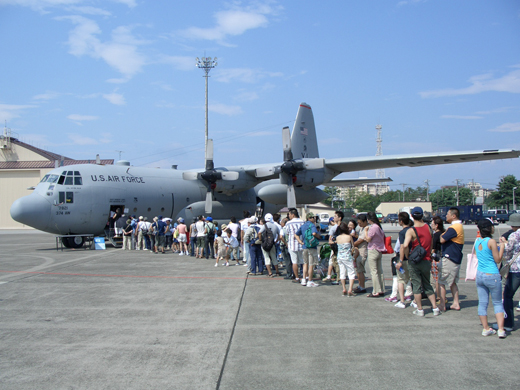 | |
Friendship Festival - Local Japanese entering a C-130 |
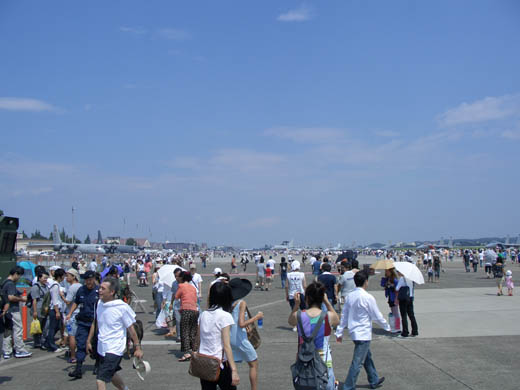 | |
Friendship Festival - Picture of Flightline |
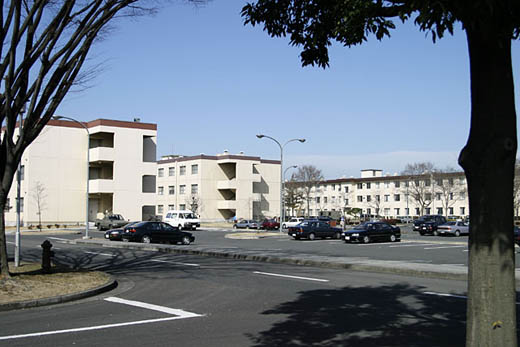 | |
Housing for unaccompanied personnel |
Yokota has provided support for fighter, bomber, and military airlift operations, hosting B-26 Invader, B/RB-29 Superfortress, P/F-51 Mustang, KB-50J Aerial Tankers, F-94 Starfire, B/RB-57 Canberra, C-54 Skymaster, F-86D Sabre, F-102 Delta Dagger, McDonnell Douglas F-4D Phantom II, F-100 Super Sabre, F-105 Thunderchief, C-5 Galaxy, C-141 Starlifter, and C-130 Hercules units.
Operational history
The facility which houses Yokota Air Base was originally constructed by the Imperial Japanese Army in 1940 as Tama Airfield, and used as a flight test center. During World War II Yokota became the center of Japanese Army Air Forces flight test activities and the base was the site of the first meeting between Japanese and Italian wartime allies.
Postwar years
With the end of hostilities and the Japanese surrender in September 1945, a detachment of the United States Army 1st Cavalry Division arrived at the base on 4 September. The 1st Cav named the facility Fussa Army Airfield, then renamed it Yokota Army Airfield at the end of September.
The initial USAAF use for the base was for airlift operations when the 2d Combat Cargo Group arrived with four C-47 Skytrain squadrons. When the old runway deteriorated under heavy usage, the runway was repaired and Yokota supported operations of the Douglas A-26 Invader-equipped 3d Bombardment Group by August 1946. Additional construction during the 1940s and 1950s was completed and the base reached its current size around 1960.
On the occasion of extension, the course of Hachiko Line and national highway Route 16 was changed, and Itsukaichi highway was divided.
During the initial postwar occupation years, Yokota hosted the following known USAAF/USAF units:
- 20th Combat Mapping Group (October 1945 - April 1946) (F-7 (B-24) Liberator)
- 8th Reconnaissance Group (June 1946 - October 1947) (F-7 (B-24) Liberator)
- 71st Reconnaissance Group (February 1947 - April 1949)
(RB-17, RB-29, RF-51, RF-61, and RF-80)
These units performed photographic reconnaissance and mapping of Japan and South Korea.
- 6th Night Fighter Squadron (1946–47) (P-61A/B)
Deactivated and redesignated as 339th Fighter Squadron (347th Fighter Group) with F-82F/G Twin Mustangs at Nagoya AB Japan.
- 3d Emergency Rescue Squadron (July 1947 - April 1950) (SB-17G)
Flew modified B-17G bombers equipped under their bellies with a 27-foot boat (termed the A-1) that could be dropped by parachute and which contained enough food, water, and clothing for twelve survivors to last for about twenty days in the ocean.
Korean War
During the Korean War, Yokota was used for combat missions over North and South Korea. Known units based there were:
- Fighter units
- 27th Fighter-Escort Wing (November - December 1950)
Flew F-84E Thunderjets on armed reconnaissance, interdiction, fighter escort, and close air support missions.
- 35th Fighter-Interceptor Wing (April - August 1950)
Flew Lockheed F-80Cs on air defense missions.
- 339th Fighter-All Weather Squadron (April - August 1950)
Attached to 35th Fighter-Interceptor Wing and flew F-82F/G Twin Mustang missions over South Korea during the first few months of hostilities.
- Bombardment units
- 325th, 326th, 327th Bombardment Squadrons (92d Bombardment Group) (July - October 1950)
Deployed squadrons from Spokane AAFld (later, Fairchild AFB), Washington. Flew B-29 Bombing missions over North Korea.
- 98th Bombardment Wing (343d, 344th, 345th Bomb Squadrons) (August 1950 - July 1954)
Group, then Wing deployed from Spokane AAFld (later, Fairchild AFB), Washington. Flew B-29 Bombing missions over North Korea. Two after arriving at Yokota, the squadrons a bomb mission against marshalling yards at Pyongyang, North Korea. The 98th BG engaged primarily in interdiction of enemy communications centers but also supported UN ground forces. Interdiction targets included marshalling yards, oil centers, rail facilities, bridges, roads, troop concentrations, airfields, and military installations.
- Reconnaissance units
- 31st Strategic Reconnaissance Squadron, Photographic (July-August 1950)
Flew combat missions to provide FEAF Bomber Command with target and bomb-damage assessment photography.
- 91st Strategic Reconnaissance Squadron, Medium, Photographic (December 1950 - December 1954)
Assigned to 407th Strategic Fighter Wing (1953–54) See 91st Intelligence Squadron
Absorbed the personnel and resources of the 31st Strategic Reconnaissance Squadron in Japan. Using RB-29, RB-45, RB-50 and RB-36 aircraft, it performed target and bomb-damage assessment photo and visual reconnaissance for FEAF Bomber Command, flew other special photographic missions, and conducted electronic "ferret" reconnaissance to determine frequency, location, and other characteristics of enemy ground radar. The squadron also performed shipping surveillance over the Sea of Japan near the Siberian coast and leaflet drops over North Korea. Beginning in late 1952, rotating aircrews of the Philippine-based 581st Air Resupply and Communications Wing augmented the 91st SRS in flying leaflet missions.
- 512th Bombardment Squadron (January - August 1950)
Operated the B/RB/WB-29 aircraft and flew weather reconnaissance missions.
- 56th Weather Reconnaissance Squadron (September 1951 - July 1972)
Replaced the 512th Bomb Squadron in their weather reconnaissance mission. They operated WB-50, WC-135B and RB-57 aircraft used to sample airborne nuclear debris as well as weather patterns in the Pacific.
- In fact, the 56th was first the 56th Strategic Recon Squadron. It became the 56th WRS later. And, for several years the only aircraft were modified B-29s.
About 1957 the B-29's began to be replaced with B-50's, and the unit continued to fly two missions a day, plus flying into any typhoons in the South Pacific. In 1957 the 56th lost a plane coming back from a mission, as it crashed into a hill not far from the base. All on board were killed.
Cold War
With the hostilities in Korea ending in 1953, Yokota Air Base returned to a peacetime Cold War status. Two major wings were stationed at the base during the 1950s, the 67th Reconnaissance Wing (1956–60) flying RF-80s, RF-84s and lastly RF-101s. The 35th Fighter-Interceptor Wing (1954–57) flew F-86 Sabres from the base. A Tactical Air Command air refueling unit, the 421st Air Refueling Squadron Flew KB-29s,and later KB-50Js from Yokota from 1953-65. All of these units were under the command of the 41st Air Division.
The 35th TFW was reassigned in 1957 and the 67th TRW in 1960. Worldwide DOD Budget restrictions in the late 1950s caused several PACAF wings based in Japan to be reassigned or deactivated. These tactical fighter units were replaced by the Martin B-57 equipped 3rd Bombardment Wing where it trained in bombardment, reconnaissance and aerial refueling operations. The Air Defense Command 40th Fighter-Interceptor Squadron (December 1961 - May 1962) equipped with the Convair F-102 Delta Dagger stood an air defense mission.
The 6102d Air Base Wing assumed host unit status for the base, being replaced by the 6144th TFW (both temporary units) in 1964.
The Vietnam War resulted in an increased combat and airlift aircraft presence at the base. Yokota was used for ferrying B-52s to Southeast Asia along with being a base for US-based deployed F-105 Tactical Fighter Squadrons (35th, 36th, 80th). The 610th Military Airlift Support Squadron (1966–78) was created by Military Airlift Command to service the large increase in transiting airlift. The 65th Military Airlift Support Group (1969–71) was a headquarters organization for MAC airlift support squadrons in the Pacific and Far East.
The F-105 squadrons deployed frequently to USAF-operated bases in Thailand to fly combat missions over North and South Vietnam, and to South Korea for alert missions. Initially the fighter squadrons were under the command of the 6441st Tactical Fighter Wing, activated in July 1964 to control the F-105 squadrons after their parent organization, the 8th Tactical Fighter Wing, relocated to George Air Force Base, California, to become a McDonnell Douglas F-4 Phantom II unit. With the reassignment of the 347th Fighter Wing to Yokota in 1968, the 347th assumed responsibility for all tactical fighters until its reassignment to Kunsan AB, South Korea, in March 1971.
In 1971, all combat squadrons were transferred to Kadena and Misawa Air Base and Yokota became a non-flying station hosted by the 475th Air Base Wing. The 475th had no numbered flying squadrons, but operated a few T-39 Saberliners and UH-1 helicopters, along with supporting transient MAC cargo and passenger aircraft. Assigned flying squadrons returned to Yokota in 1975 when the 345th Tactical Airlift Squadron was assigned with its C-130Es.
Headquarters, Fifth Air Force was transferred to Yokota on November 11, 1974, being transferred from Fuchu AS, Japan.
Post-Cold War
In 2005, the Japanese government announced that the headquarters of the Japan Air Self-Defense Force would be moved to Yokota.
The Tokyo Metropolitan Government has advocated opening Yokota to civilian flights, as a method of relieving traffic at Haneda and Narita Airport.
In April 2010 Colonel Frank Eppich, the United States Air Force commander of base, banned screenings of the film The Cove at the base theater. A base spokesman said that The Cove was banned because using a base venue to display the film could be seen as an endorsement of the film. The spokesman added, "We have a lot of issues with Japan...and anything done on an American base would be seen as an approval of that event."
Amenities
Friendship Festival
Each year in August, Yokota Air Base opens the gates to the Japanese community for its annual Friendship Festival. For two days, local residents can learn about Yokota Air Base. Food and events are provided for all ages. Roughly 200,000 visitors show up each year, although non-Japanese visitors may be turned away from the gates for security reasons.
For those 2 days, visitors are able to examine many types of aircraft and even tour some of the large cargo planes from inside.
Hotels and lodging
Kanto Lodge - DSN (315) 224-2000
The Kanto Lodge is one of PACAF's largest hotel operations. Each year, over 130,000 personnel are housed in the Kanto Lodge's eleven on-base facilities. The new, 125-room Temporary Lodging Facility (TLF) opened in the summer of 2001 .
Education
The Department of Defense Education Activity operates schools at Yokota for children of personnel assigned to the base.
- Joan K. Mendel Elementary School (formerly known as Yokota East Elementary School)
- Yokota West Elementary School
- Yokota Middle School: School Dedication Ceremony took place on 13 June 2000. YMS initial year began with only grades 7 and 8, with the upstairs specialty wing housing High School classes until construction modifications to YHS were competed. Class officially began August 2000.
- Yokota High School
Higher educational opportunities for those in the military and working for the Department of Defense, as well as for family members at Yokota are available through several contracted academic institutions. For example:
- The Asian Division of University of Maryland University College (UMUC)[1]
The base was the setting of Almost Transparent Blue, a best-selling novel written by Ryu Murakami and published in 1976. It is also the setting of parts of The Yokota Officers Club : A Novel by Sarah Bird.
| General Info
|
| Country |
Japan
|
| ICAO ID |
RJTY
|
| Time |
UTC+9
|
| Latitude |
35.748492
35° 44' 54.57" N
|
| Longitude |
139.348483
139° 20' 54.54" E
|
| Elevation |
463 feet
141 meters
|
| Type |
Military
|
| Magnetic Variation |
007° W (01/06)
|
| Beacon |
Yes
|
| Operating Agency |
MILITARY
|
| Island Group |
Honshu I
|
| International Clearance Status |
Airport of Entry
|
| Communications
|
| TWR |
134.3
315.8
|
374 AW COM CNTR
(Call FUJI CON) |
128.0
325.8
276.2
349.4
|
| PTD |
119.0
313.6
|
| AMC COMD POST |
128.0
349.4
|
| PMSV METRO |
344.6
|
| GND |
133.2
308.6
|
| DEP |
122.1
363.8
|
| CLNC DEL |
131.4
249.95
|
| ATIS |
128.4
281.0
|
| APP |
118.3
123.8
261.4
270.6
|
| RADAR ADVSY SVC |
118.3
120.7
261.4
270.6
317.85
|
| AG |
292.1
|
| Communications Remarks |
|
| TWR |
TWR on-call 1300-2000Z dly with 20 min response.
|
| RDO |
Secure capable.
|
| PTD |
VFR tran copter acft ctc with ETA, gnd handling, and VIP info prior to entering CTLZ.
|
| POST |
AMC/AMC contract aircraft must ctc AMC COMMAND POST prior to ldg and make rqr known.
|
| PMSV |
(Unuse 210 to 330 byd 40 NM blw 14,000').
|
| ATIS |
(MP 2245-2315Z Thu)
|
| GND |
All aircraft contact prior to engine start.
|
| APP |
118.3 270.6 (Sfc to upper limits of airspace outside 30 NM of YOK, abv 5000' wi30 NM of YOK) 123.8 261.4 (Sfc to 5000' wi 30 NM of YOK)
|
| A/G |
See Global HF Systems listing in FIH.
|
| Runways
|
| ID |
Dimensions |
Surface |
PCN |
ILS
|
| 18/36 |
11000 x 200 feet
3353 x 61 meters |
CONCRETE. |
060RCWT |
YES
|
| Navaids
|
| Type |
ID |
Name |
Channel |
Freq |
Distance From Field |
Bearing From Navaid
|
| TACAN |
YOK |
YOKOTA |
085X |
- |
At Field |
-
|
| Supplies/Equipment
|
| Fuel |
JP-8, SemiKeroscene MIL Spec T-83133, without icing inhibitor
|
| Oil |
O-128, 1100,(Dispersant)Reciprocating Engine Oil(MIL L 22851 Type II)
O-133, 1010, jet Engine Oil (MIL l 6081)
O-148, MIL L 7808 (Synthetic Base), Turboprop/Turboshaft Engine
|
| Other Fluids |
W, Water Thrust Augmentation - Jet Aircraft
SP, Single Point Refueling
LPHOX, Low pressure oxygen servicing
LOX, Liquid oxygen servicing
|
| JASU |
A/M32A-86
AC:115/200v, 3 phase, 90 kva, 0.8pf, 4 wire, DC: 28v,1500 amp, 72kw
AM32-95
150+/-5lb/min (2055+/- 68cfm) at 51+/- 2psia
MA-1A
82lb/min (1123cfm) at 130 deg air inlet temp,45psia(min) air outlet
|
| Remarks
|
| A-GEAR |
Ctc ctl twr 30 min prior for apch end BAK-12.
|
| CAUTION |
Terrain rises rapidly W of final apch crs. If on vectors to final, DO NOT CROSS W of YOK R-185 or R-355. Turn inbd on apch if no turn is rcv. Do not mistake Iruma 7 NM NNE or Tachikawa 4 NM ESE for Yokota. Advs ATC when making AUTOLAND/COUPLED ILS Apch. Ctl veh tfc cros ovrn both ends of rwy. C-130 acft conduct maint eng runs on prk lctn W of rwy. Prop wash may adversely affect acft ctl performance. Ctl twr blind spots on Golf Taxiway and on A twy. Foxtrot twy and most of E ramp twys unlgt; day/VFR only, follow-me rqr night/IFR. Hawks freq cir over the fld, crows fly across rwy, advs ATC or PTD of haz bird act. Peak bird act Apr-Oct. Pers and eqpt cros Golf twy dly 2230-1000Z. Pers and eqpt working dly 2230-0730Z near Golf twy. Numerous obst on/off-base at both end of rwy are not obst lit.
|
| CSTMS/AG/IMG |
Avbl btn 1300-2000Z dly with 4 hr PN.
|
| FLUID |
LPOX LOX W-Ltd qty, PN rqr, Fone DSN 225-9187; SP
|
| FUEL |
J8
|
| JASU |
(A/M32A-86) (AM32-95) (MA-1A)
|
| LGT |
Nstd ALS, SFLs up to 200' fr rwy thld; SFL and PAPIs lgt are step capable. Rwy 36 PAPI GS not coincidental with ILS GS. Rwy 18 PAPI GS not coincidental with ILSGS.
|
| MISC |
PREFERRED ARR/DEP RTE in Sec E will be used. All AMC msn acft ctc AMC CTL CNTR 30 min out with arr/dep info and coord concurrent svc. All acft with code 6 and abv must ctc 374 AW COM CNTR 15 min (copters 10 min) prior to ldg with arr msg and block time; copters with DV use pad (primary) DV-1 (RED CARPET), altn DV-2 (south of DV-1). Ltd stor of COMSEC packages SECRET and blw avbl at Base OPS. See FLIP PLANNING AP/3. Base wx open 24 hr to incl obsn. Remote wx briefings/phonepatches avbl 24hr fr 17th Wx Sqdn at DSN: 315-449-7924/8333/8335. 17th Wx Sqdn METRO ltd svc. Base OPS has no COMSEC avbl for Tran aircrew and ltd COMSEC stor avbl. Crews should plan to arr with appropriate amount of COMSEC to compl entiremsn.
|
| NS ABTMT |
See FLIP Planning, AP/3. Nationally estab quiet hr in eff at YOKOTA 1300-2100Z dly, program strictly enforced. Dur wkend, 0900Z Fri to 2100Z Mon, tran acft exp str-in full stop ldg, multi apch not auth. Dur wkd from 1100-1300Z, no tran multi apch.
|
| OIL |
O-128-133-148
|
| RSTD |
PPR exc AMC, AMC Chan, AIREVAC, HQ PACAF/5AF drct msn and SAAM msn. Request PPR at least 24 hr in advance, but no earlier than 3 days prior. New PPR rqr if ATAor ETA differs by more than 2 hrs. DSN 225-7006/7214, C0118131175-57006/57214.AMC Comd Cntr, DSN 225-4400, req no AMC or AMC contract acft sked arr/dep after1230Z, and rqr PN for AMC or AMC contract acft which must arr/dep after 1230Z. Rwy clsd ev sec Fri mthly 0300-0800Z; will open to support Patriot Express msn.Copter avoid ovft of grass area btn rwy end and ramp S of Delta twy. Acft will maint twy cntrline dur taxi opr (300' min btn acft in trail). No vert tkof or ldgby F/W acft (AV8). Non TACAN equip acft radar rqr for dep pro. Wide-bodied acfttraveling S on Foxtrot will not turn W onto Bravo East.
|
| TFC PAT |
Jet/Turbo-prop rectangular and clsd tfc -2000', Recip -1500', Overhead -2500', Clsd VFR tfc pat not auth 2145-2245Z, 0245-0345Z, and 0730-0830Z dly. Trans heli must fly VFR pat to SE helipad/rwy only; fly pat to SE only; do not fly north ofDisp-6; do not overfly Mizuho town.
|
| TRAN ALERT |
Svc avbl 2100-1300Z dly on a priority, space avbl basis. Full svc avbl for C130. Ltd svc avbl for AMC acft. Extremely ltd svc for all other acft. No tow barfor C-37 acft, see AP/3. Multi acft arr/dep, stagger 5 min per acft. Unableto support lcl/round robin msn. DSN 225-9385, C0118131175-59385.
|
The content above was published at Airports-Worldwide.com in 2010.
We don't guarantee the information is fresh and accurate. The data may be wrong or outdated.
For more up-to-date information please refer to other sources.
|
 |



